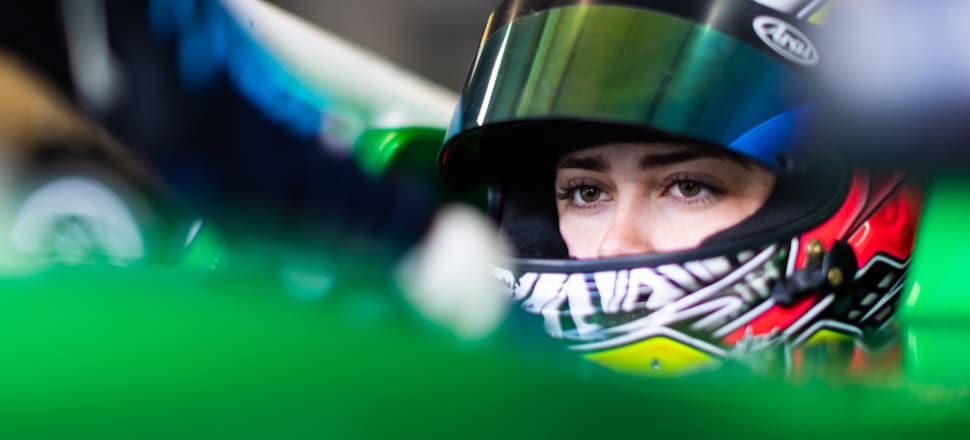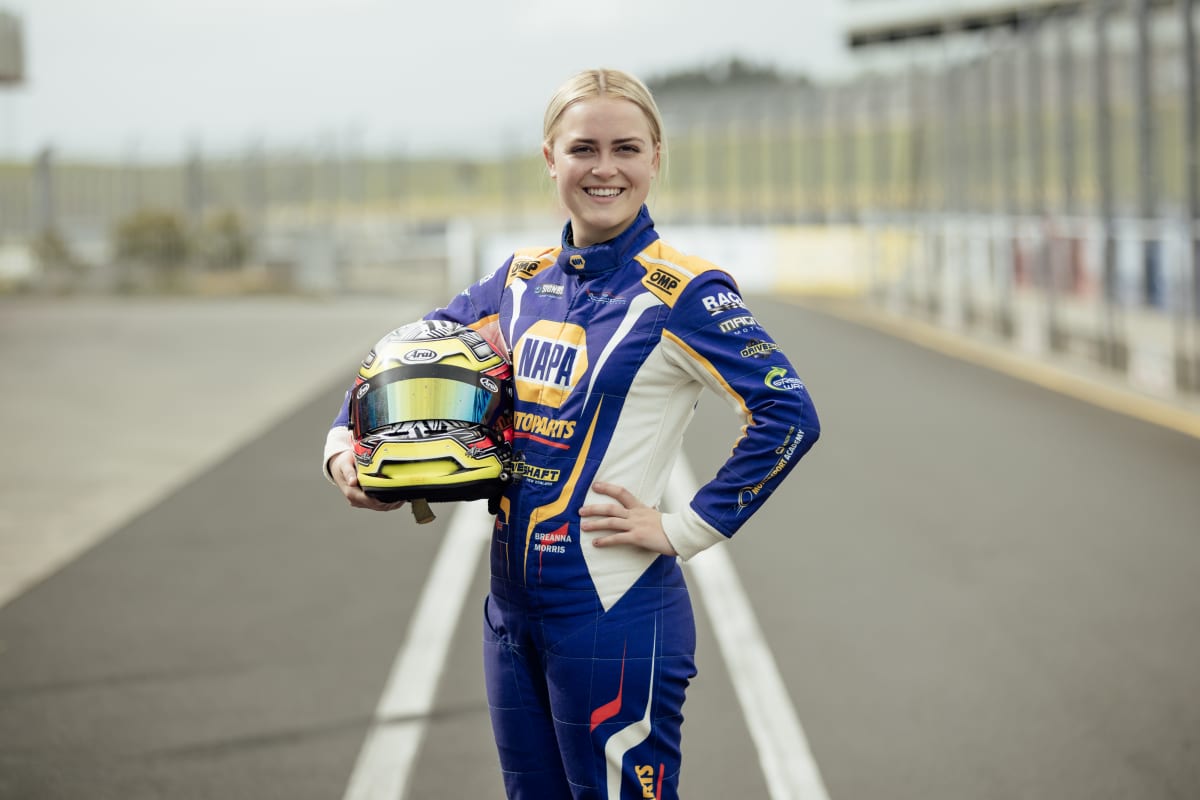
Women haven't raced in Formula One in 44 years, but that doesn't stop young drivers like Kiwi Bree Morris wanting to smash down barriers. With a start in NZ's Grand Prix class, she's on her way, she tells Suzanne McFadden.
When Bree Morris finished high school last year and faced the traditional question of "What are you going to do now?", she always answered with confidence. “I’m going to race cars,” she said.
There was never any doubt in the now 18-year-old’s mind that she could make a career as a professional race car driver.
And true to her word, Morris is well on her way, with a place on the grid in this season’s Toyota Racing Series (TRS), the country’s premier single-seater class. It takes her one step closer to her goal of driving on the world stage within the next few years.
Morris will be just the seventh female driver to break into the series. But the Auckland girl who started driving karts as a 10-year-old doesn’t see being a woman behind the wheel as anything special, or equally, as a barrier in her career.
“I can’t really tell you a difference between male and female drivers. Yeah, I know there aren’t that many female drivers in the sport, but I’ve grown up in a generation where it isn’t a surprise to me,” she says.
“You always get people who assume you are male. I’ve heard people ask my dad: "So how old’s your son?’”
READ MORE:
* Fast driver's Xmas gift comes early
* Formula One's new fans
Globally, only 1.5 percent of licensed motorsport drivers are women.
“It doesn’t matter what gender you are, anyone has the right to drive these cars if they have the talent,” Morris says.

It’s a hot topic in motorsport right now. Why has no woman driven in Formula One since Leila Lombardi in 1976?
There definitely isn’t a case that they’re not strong enough.
A 2019 Michigan State University study has proof that women drivers – even with a decade less experience – react and respond just as well as their male counterparts on the track.
There was a misperception, assistant professor David Ferguson says, that women in certain phases of their menstrual cycle would potentially fatigue faster and become a safety risk to other drivers. Their results say that’s just not true.
The study has proven driving a race car is equally stressful for female and male drivers.
Morris admits her only worry going into TRS - which starts on January 13 at Highlands Motorsport Park, and includes the NZ Grand Prix - is that she won’t have had enough time testing in the state-of-the-art FT-60 race car.
Even at 18, she knows being race fit in these cars is much more important than being physically fit.
The ‘wings and slicks’ car - wings to make it more aerodynamic and full slick tyres for speed - is faster and harder to drive than the Formula Ford cars Morris has driven the past two seasons (she’s the reigning North Island champ).
“The FT-60s are very heavy to drive. But the thing is, there’s no way a female is not capable of driving these cars,” she says.
“Let’s say a guy in the gym can bench-press 80kg and I can only bench-press 20kg. Their 80kg bench press is not going to get them anywhere in that car. You need in-car strength, and you’ll never get that at the gym.
“Sure, there’s no way you can get the strength to drive those cars without going to the gym. But laps and laps on the track give you race fitness, and make you more familiar with the car and give you more feedback.”
Morris' challenge over the next six weeks is to get good track time – but probably in the FT-50, an early incarnation of the car she’ll drive during the series, raced on five back-to-back weekends.

Morris knows that means driving a minimum of 100 laps at the track a day. “It takes a good whole day, coming in, changing, having a break, going back out,” she says.
“But to be honest, I’d much rather drive 100 laps than go to the gym for an hour.”
She won't be the only female driver in the TRS, joined by up-and-coming American racer Chloe Chambers, fresh from a season in the W-Series driving for Jenner Racing and the US Formula Four.
Morris is also on the hunt for the last of the funding for her $200,000 campaign. “I just need a little bit more of a helping hand,” she says.
She gave up her job in a local supermarket a few months ago so she could concentrate on securing a start in TRS. “Opportunities like TRS don’t just come to you,” she says. “It took me three months of hard work.”
It was a generous grant from the Tony Quinn Foundation that got Morris across the line. The foundation helps young Kiwi drivers to realise their dreams – like Hunter McElrea, who just won the American Indy Lights ‘Rookie of the Year’ title, and Liam Lawson, who’s claimed four victories in Formula Two this season and drove Max Verstappen’s Formula One car in the opening practice session of the Abu Dhabi Grand Prix last month.
Morris will represent both the foundation and the Hampton Downs NZ Racing Academy during TRS. The chief instructor of the academy, two-time TRS champion Daniel Gaunt, has been mentoring Morris, and describes her as “the best female driver I have ever seen at this stage in her career”.
Others in New Zealand motorsport can’t speak highly enough of Morris’ talent and her desire to succeed.
McLaren XE co-drivers Tanner Foust and Emma Gilmour celebrate finishing 2nd in the Energy X Prix final
Kiwi rally driver Emma Gilmour is one of the first female drivers Morris looked up to. Gilmour made history last month when she became McLaren’s first woman driver to stand on the podium, at the final Extreme E event of the season in Uruguay.
“It’s awesome what she’s doing,” Morris says. “We send messages on Instagram. She definitely supports me in my racing.”
Gilmour is equally impressed with Morris’ progress. “I’m really excited for Bree and her opportunity with the TRS,” Gilmour says. “She has a lot of talent and it will be great for her to gain experience on home soil. I can’t wait to cheer her on.”
Morris has only a faint memory of her first time behind a steering wheel, as a keen 10-year-old at a have-a-go day at the Mt Wellington karting track.
“And next minute, Dad’s driving home from racing speedway in Christchurch with a go-kart on the back of his midget trailer,” she says. Her dad, Steve, has been her right-hand-man through her career this far.
By the age of 12, Morris had stamped her mark on the karting scene, winning the New Zealand Vortex Mini ROK class - which earned her a trip to Milan to race in the ROK Cup Italy series for a weekend. That gave Morris a small taste of driving overseas and a realisation motor-racing could become a serious part of her life.
She’d been one of those kids who tried as many sports as time, and parent transport, would allow: netball, football, rugby sevens, touch, flippa ball. But in 2016, when she won that first national karting title, she gave almost all of the codes away.
All but netball, which Morris kept playing right through her years at Westlake Girls’ High. “But my knees definitely didn’t like that game,” she says.
From karts she progressed to single-seater racing in Formula Vee before taking the next step to Formula Ford two seasons ago.
“I enjoyed karting so much I felt a single-seater related more to that kind of driving than a tin top does,” she says. “It’s more of a race car, it has more emotion to it. I can drive a tin top on the road every day.”

Like most young women in single-seater racing, smashing down barriers to get into Formula One would be the ultimate for Morris.
“It took Liam Lawson five years to get to Formula One. So I hope to be racing overseas next year, after my second TRS. And the next year, I’m halfway there, right?” she says.
She's hit her straps at just the right time - with new initiatives to help women drivers reach motorsport’s pinnacle.
Formula One has launched the F1 Academy – an all-female racing series for 15 young drivers planning to start next year, and help equip them with the skills to race in Formula Three as a starting point.
The academy is seen as another route for young women alongside the W-Series, which after three seasons has been hindered by financial difficulties.
Sophia Floersch has been open with her feelings about women breaking into Formula One
A lot of criticism remains that Formula One’s male-dominated environment makes it too hard for a woman to break through. Talented female driver Sophia Floersch told German broadcaster DW it’s increasingly the older generation who “don’t approve of a woman succeeding in Formula One”.
“There’s this image of a tough, sweat, battle-hardened racing driver who has to be a man. That can’t change in their eyes,” she says.
Morris wants to be seen as a driver who’s made racing her career.
“You could put me in F1, you could put me in IndyCar, you could put me in anything - as long as that’s my career," she says.
"Because that’s what I get out of bed every morning for.”







